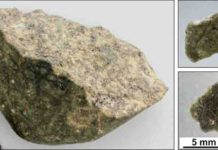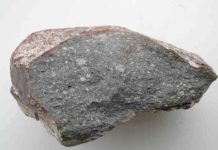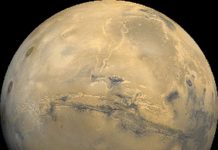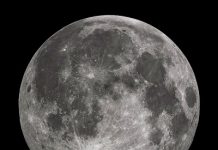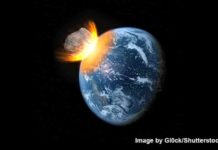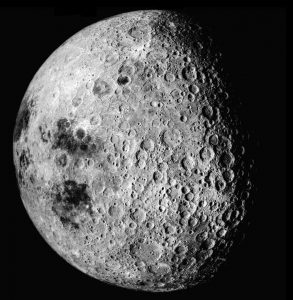
Credit: NASA
A layer of iron and other elements deep underground is the evidence scientists have long been seeking to support the hypothesis that the moon was formed by a planetary object hitting the infant Earth some 4.5 billion years ago, a new study led by Johns Hopkins University scientists argues.
Published in the current issue of the journal Nature Geoscience, the paper uses laboratory simulations of an Earth impact as evidence that a stratified layer beneath the rocky mantle — which appears in seismic data — was created when Earth was struck by a smaller object. The authors argue this was the same impact that sent a great mass of debris hurtling into space, creating the moon.
“Our experiments bring additional evidence in favor of the giant impact hypothesis,” said Maylis Landeau, the lead author of the paper, who was a post-doctoral fellow in Johns Hopkins’ Department of Earth and Planetary Sciences when the experiments were conducted. “They demonstrate that the giant impact scenario also explains the stratification inferred by seismology at the top of the present-day Earth’s core. This result ties the present-day structure of Earth’s core to its formation.”
Landeau, now a Marie Curie Fellow at the University of Cambridge, co-wrote the paper with Peter Olson, research professor in the Department of Earth and Planetary Sciences, Benjamin H. Hirsh, who was an undergraduate at Johns Hopkins, and Renaud Deguen of Claude Bernard University in Lyon, France.
Olson said the giant impact argument for the formation of the moon is the most prevalent scientific hypothesis on how Earth satellite was formed, but it is still considered unproven because there’s been no “smoking gun” evidence.
“We’re saying this stratified layer might be the smoking gun,” said Olson. “Its properties are consistent with it being a vestige of that impact.”
Their argument is based on seismic evidence of the composition of the stratified layer — believed to be some 200 miles thick and lie 1,800 miles below Earth’s surface — and on laboratory experiments simulating the turbulence of the impact. The turbulence in particular is believed to account for the stratification — meaning a mix of materials in layers rather than a homogeneous composition — at the top of the core.
The stratified layer is believed to consist of a mix of iron and lighter elements, including oxygen, sulfur and silicon. The very existence of this layer is understood from seismic imaging, as it lies far too deep underground to be sampled directly.
Up to now, most simulations of the impact have been done numerically, and have not accounted for impact turbulence, Olson said. Olson said turbulence is difficult to simulate mathematically and no computer model has yet done it successfully.
The researchers in this experiment simulated the impact using liquids meant to approximate the turbulent mixing of materials that would have occurred when the planetary object struck when Earth was just about fully formed — a “proto-Earth,” as scientists call it.
Olson said the experiments depended on the principle of “dynamic similarity.” In this case, that means a way to make reliable comparisons of fluid flows without replicating the scale, materials and force of the original Earth impact, which would be impossible. Instead, the experiment was meant to simulate the key ratios of forces acting on each other to produce the turbulence of the impact that could leave behind a layered mixture of material.
The researchers conducted more than 60 experiments in which about 3.5 ounces of saline or ethanol solutions representing the planetary projectile that hit Earth was dropped into a rectangular tank holding about six gallons of fluid representing the early Earth. In the tank was a combination of fluids in layers that do not mix: oil floating on the top to represent Earth’s mantle and water below representing Earth’s core.
The analysis of the impact showed that a mix of materials was left behind in varying amounts, and also that the distribution of the mixture depended on the size and density of the projectile hitting the “Earth.” The larger the projectile, the more likely the entire core of Earth, and not just a layer, would be a mix of material. The authors argue for a smaller moon-forming projectile, smaller or equal to the size of Mars, a bit more than half the size of Earth.
Reference:
Maylis Landeau, Peter Olson, Renaud Deguen, Benjamin H. Hirsh. Core merging and stratification following giant impact. Nature Geoscience, 2016; DOI: 10.1038/ngeo2808
Note: The above post is reprinted from materials provided by Johns Hopkins University.




